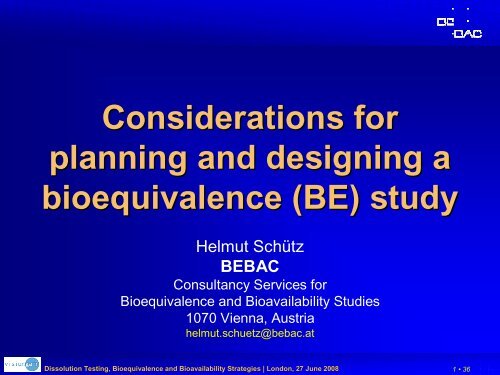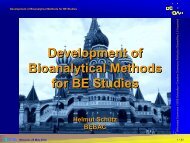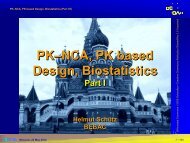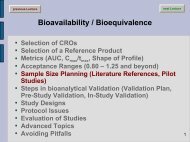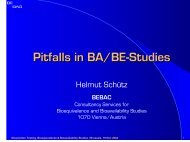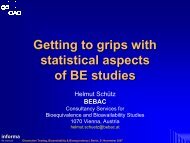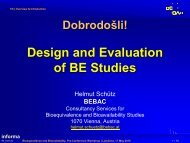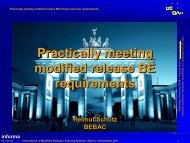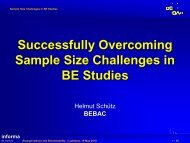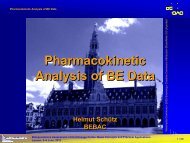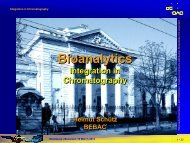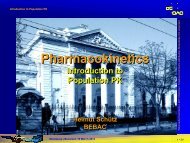Considerations for planning and designing a bioequivalence (BE ...
Considerations for planning and designing a bioequivalence (BE ...
Considerations for planning and designing a bioequivalence (BE ...
You also want an ePaper? Increase the reach of your titles
YUMPU automatically turns print PDFs into web optimized ePapers that Google loves.
<strong>Considerations</strong> <strong>for</strong><br />
<strong>planning</strong> <strong>and</strong> <strong>designing</strong> a<br />
<strong>bioequivalence</strong> (<strong>BE</strong>) study<br />
Helmut Schütz<br />
<strong>BE</strong>BAC<br />
Consultancy Services <strong>for</strong><br />
Bioequivalence <strong>and</strong> Bioavailability Studies<br />
1070 Vienna, Austria<br />
helmut.schuetz@bebac.at<br />
Dissolution Testing, Bioequivalence <strong>and</strong> Bioavailability Strategies<br />
es | London, 27 June 2008 1 • 36
Main Topics<br />
Defining study objectives<br />
Protocol development<br />
Ethical considerations<br />
Assessing clinical, laboratory,<br />
<strong>and</strong> analytical facilities<br />
Selecting subjects<br />
Adhering to guidelines<br />
DREAM…<br />
Dissolution Testing, Bioequivalence <strong>and</strong> Bioavailability Strategies<br />
es | London, 27 June 2008 2 • 36
Main Topics<br />
Ethical considerations<br />
Ethical considerations<br />
REALITY…<br />
REALITY…<br />
REALITY…<br />
REALITY…<br />
Defining study objectives<br />
Adhering to guidelines<br />
Adhering to guidelines<br />
Selecting Selecting subjects subjects<br />
Protocol development<br />
development<br />
Assessing Assessing clinical, clinical, laboratory, laboratory,<br />
<strong>and</strong> analytical analytical facilities facilities<br />
Dissolution Testing, Bioequivalence <strong>and</strong> Bioavailability Strategies<br />
es | London, 27 June 2008 3 • 36
Defining study objectives<br />
According to the NfG (3. Design <strong>and</strong> Conduct<br />
of Studies, paragraph 2):<br />
‘A <strong>bioequivalence</strong> study is basically a<br />
comparative bioavailability study designed<br />
to establish equivalence between test <strong>and</strong><br />
reference products.’<br />
Comparative BA,<br />
designed to demonstrate <strong>BE</strong>,<br />
reference = innovator’s product.<br />
EMEA Human Medicines Evaluation Unit / CPMP<br />
Note <strong>for</strong> Guidance on the Investigation of Bioavailability <strong>and</strong> Bioequivalence<br />
CPMP/EWP/QWP/1401/98 (26 July 2001)<br />
http://www.emea.eu.int/pdfs/human/ewp/140198en.pdf#page=6<br />
Dissolution Testing, Bioequivalence <strong>and</strong> Bioavailability Strategies<br />
es | London, 27 June 2008 4 • 36
Defining study objectives<br />
Comparative BA<br />
true experiment; no bibliographic comp.<br />
Designed to demonstrate <strong>BE</strong><br />
variability,<br />
deviation of test from reference,<br />
drop-out rate,…<br />
to be able (statistical power) to demonstrate <strong>BE</strong><br />
Reference = innovator’s product<br />
#1: <strong>BE</strong> [90%–125%]<br />
#2: <strong>BE</strong> [80%–110%]<br />
#3: not <strong>BE</strong> [76%–103%]; (but ‘<strong>BE</strong>’ to #2)<br />
Dissolution Testing, Bioequivalence <strong>and</strong> Bioavailability Strategies<br />
es | London, 27 June 2008 5 • 36
Terminology<br />
Bioavailability<br />
relative BA<br />
Comparative BA<br />
absolute BA<br />
Bioequivalence<br />
Food effect<br />
PK interaction<br />
Pilot study<br />
Dissolution Testing, Bioequivalence <strong>and</strong> Bioavailability Strategies<br />
es | London, 27 June 2008 6 • 36
Assumptions<br />
World ‘Reality’<br />
α<br />
β<br />
Model ‘Data’<br />
H0<br />
HA<br />
Theory ‘Truth’<br />
Dissolution Testing, Bioequivalence <strong>and</strong> Bioavailability Strategies<br />
es | London, 27 June 2008 7 • 36
Defining study objectives<br />
Definition of <strong>BE</strong> (NfG, Section 2.4)<br />
‘Two medicinal products are bioequivalent if<br />
they are pharmaceutically equivalent or<br />
pharmaceutical alternatives <strong>and</strong> if their bioavailabilities<br />
after administration in the same<br />
molar dose are similar to such degree that<br />
their effects, with respect to both efficacy <strong>and</strong><br />
safety, will be essentially the same.’<br />
Dissolution Testing, Bioequivalence <strong>and</strong> Bioavailability Strategies<br />
es | London, 27 June 2008 8 • 36
Defining study objectives<br />
In vivo <strong>BE</strong> m<strong>and</strong>atory, if<br />
Waiving (NfG Section 5.1.1) not possible<br />
in MA of generics<br />
Manufacturing changes (EU Major variation type<br />
II(d)-(f) ~ SUPAC Level 3)<br />
Pharmacokinetic interaction studies,<br />
Studies of fixed-combination products.<br />
‘[…] are similar to such degree that their effects,<br />
with respect to both efficacy <strong>and</strong> safety,<br />
will be essentially the same.’<br />
Dissolution Testing, Bioequivalence <strong>and</strong> Bioavailability Strategies<br />
es | London, 27 June 2008 9 • 36
Defining study objectives<br />
Concept of <strong>BE</strong> also applicable to<br />
Food effect studies,<br />
Pharmacokinetic interaction studies,<br />
Studies of fixed-combination products.<br />
‘[…] are similar to such degree that their effects,<br />
with respect to both efficacy <strong>and</strong> safety, will be<br />
essentially the same.’<br />
EMEA Human Medicines Evaluation Unit / CPMP<br />
Modified Release Oral <strong>and</strong> Transdermal Dosage Forms: Section II (Quality)<br />
CPMP/EWP/280/96, London, 28 July 1999<br />
EMEA Human Medicines Evaluation Unit / CPMP<br />
The Investigation of Drug Interactions<br />
CPMP/EWP/560/95, London, 17 December 1997<br />
EMEA<br />
Fixed Combination Medicinal Products<br />
CPMP/EWP/240/95 Rev. 1, London, 21 February 2008<br />
Dissolution Testing, Bioequivalence <strong>and</strong> Bioavailability Strategies<br />
es | London, 27 June 2008 10 • 36
Protocol development<br />
Whatever procedure you do not lay down in<br />
the protocol likely will not be accepted by the<br />
competent authorities!<br />
Clinical phase<br />
Requirements following the PK / safety profile of the<br />
API <strong>and</strong> organizational / economic constraints<br />
Screening / post treatment (in-house vs. external)<br />
Hospitalization vs. ambulatory<br />
PD <strong>and</strong>/or safety parameters<br />
Sampling / h<strong>and</strong>ling / storage / shipment<br />
Dissolution Testing, Bioequivalence <strong>and</strong> Bioavailability Strategies<br />
es | London, 27 June 2008 11 • 36
Protocol development<br />
Since in vivo <strong>BE</strong> relies on ‘rich’ PK data:<br />
Sufficient number of blood samples (C max !) / urine<br />
collection periods<br />
Sampling long enough to cover ≥80 % of AUC ∞<br />
Wash-out ≥3× t ½ (recomm. ≥5× t ½ )<br />
Saturation phase long enough to reach<br />
steady-state: ≥5× t ½ (recomm. ≥7× t ½ )<br />
Pre-dose samples (carry-over,<br />
compliance)<br />
New NewNfG: NfG: <strong>for</strong> <strong>for</strong>IRIR <strong>for</strong>mulations<br />
no nomore sampling beyond beyond<br />
72 72hours.<br />
Dissolution Testing, Bioequivalence <strong>and</strong> Bioavailability Strategies<br />
es | London, 27 June 2008 12 • 36
Protocol development<br />
Sample size <strong>planning</strong> (NfG, Section 3.1)<br />
The number of subjects required is determined by<br />
the error variance associated with the primary<br />
characteristic to be studied as estimated from<br />
a pilot experiment,<br />
previous studies, or<br />
published data,<br />
the significance level desired,<br />
the expected deviation (∆) from the reference product<br />
compatible with <strong>BE</strong> <strong>and</strong>,<br />
the required power.<br />
Dissolution Testing, Bioequivalence <strong>and</strong> Bioavailability Strategies<br />
es | London, 27 June 2008 13 • 36
Protocol development<br />
Sample size <strong>planning</strong><br />
12<br />
10<br />
8<br />
frequency<br />
6<br />
4<br />
2<br />
total<br />
0<br />
10<br />
15<br />
20<br />
C Vs<br />
25<br />
30<br />
200 m g<br />
100 m g<br />
studies<br />
Doxicycline (37 studies ref. by Blume/Mutschler, 1996)<br />
Dissolution Testing, Bioequivalence <strong>and</strong> Bioavailability Strategies<br />
es | London, 27 June 2008 14 • 36
Protocol development<br />
Power to show<br />
2×2 Cross-over<br />
<strong>BE</strong> with 12 – 36<br />
subjects <strong>for</strong><br />
CV intra = 20%<br />
n 24 → 16:<br />
power 0.896→ 0.735<br />
Power<br />
1<br />
0.9<br />
0.8<br />
0.7<br />
0.6<br />
0.5<br />
0.4<br />
0.3<br />
0.2<br />
36<br />
24<br />
16<br />
12<br />
20% CV<br />
µT/µR 1.05 → 1.10:<br />
power 0.903→ 0.700<br />
0.1<br />
0<br />
0.8 0.85 0.9 0.95 1 1.05 1.1 1.15 1.2 1.25<br />
µT/µR<br />
Dissolution Testing, Bioequivalence <strong>and</strong> Bioavailability Strategies<br />
es | London, 27 June 2008 15 • 36
Potency<br />
ANDAs approved by FDA/OGD<br />
1996–2005 (1636 studies, 12–127 subjects)<br />
with few exceptions: single dose, fasting<br />
data referring to studies demonstrating <strong>BE</strong> on<br />
AUC ∞ , AUC t , C max ; deviation test/reference:<br />
AUC ∞ 3.12% (±2.66%)<br />
AUC t 3.19% (±2.72%)<br />
C max 4.50% (±3.57%)<br />
Nwakama PE, Haidar SH, Yang YS, Davit BM, Conner DP, Yu LX<br />
Generic Drug Products Demonstrate Small Differences in Bioavailability Relative to the Br<strong>and</strong> Name<br />
Counterparts: A Review of ANDAs Approved 1996 – 2005<br />
12th Annual FDA Science Forum, April 2006: Board A-18<br />
http://www.accessdata.fda.gov/scripts/oc/science<strong>for</strong>um/sf2006/Search/preview.cfm?keyword=A&abstract_id=<br />
897&type=category&backto=search<br />
Dissolution Testing, Bioequivalence <strong>and</strong> Bioavailability Strategies<br />
es | London, 27 June 2008 16 • 36
Highly variable drugs<br />
All (!) ANDAs submitted to FDA/OGD<br />
2003–2005 (1010 studies, 180 drugs)<br />
31% (57/180) highly variable (CV ≥30%)<br />
of these HVDs/HVDPs,<br />
60% due to PK (e.g., first pass metabol.)<br />
20% <strong>for</strong>mulation per<strong>for</strong>mance<br />
20% unclear<br />
Davit BM, Conner DP, Fabian-Fritsch B, Haidar SH, Jiang X, Patel DT, Seo PR, Suh K,<br />
Thompson CL, Yu LX<br />
Highly variable drugs: observations from <strong>bioequivalence</strong> data submitted to the FDA <strong>for</strong> new generic drug<br />
applications<br />
AAPS J 10(1): 148-56 (2008)<br />
Dissolution Testing, Bioequivalence <strong>and</strong> Bioavailability Strategies<br />
es | London, 27 June 2008 17 • 36
HVDs<br />
Power to show <strong>BE</strong><br />
with 40 subjects <strong>for</strong><br />
CV intra = 30–50%<br />
µT/µR 0.95, CV intra 30%<br />
→ power 0.816<br />
µT/µR 1.00, CV intra 45%<br />
→ power 0.476 <<br />
Roulette 0.486 (!)<br />
µT/µR 0.95, CV intra 45%<br />
→ n=82 (power 0.807)<br />
Power<br />
1<br />
0.9<br />
0.8<br />
0.7<br />
0.6<br />
0.5<br />
0.4<br />
0.3<br />
0.2<br />
0.1<br />
0<br />
2×2 Cross-over<br />
30 % CV<br />
35 % CV<br />
40 % CV<br />
45 % CV<br />
50 % CV<br />
n=40<br />
0.8 0.85 0.9 0.95 1 1.05 1.1 1.15 1.2 1.25<br />
µT/µR<br />
Dissolution Testing, Bioequivalence <strong>and</strong> Bioavailability Strategies<br />
es | London, 27 June 2008 18 • 36
HVDs (US/EU)<br />
Advisory Committee <strong>for</strong> Pharmaceutical<br />
Sciences (ACPS) to FDA (10/2006) on HVDs<br />
Follow-up paper in 2008 (likely to be implemented<br />
in next Guideline)<br />
Replicate study design [TRR–RTR–RRT]<br />
Reference Scaled Average Bioequivalence (RSA<strong>BE</strong>)<br />
Minimum sample size 24 subjects<br />
Point estimate restricted to [0.80,1.25]<br />
SH Haidar, B Davit, M-L Chen, D Conner, LM Lee, QH Li, R Lionberger, F Makhlouf, D Patel,<br />
DJ Schuirmann, <strong>and</strong> LX Yu<br />
Bioequivalence Approaches <strong>for</strong> Highly Variable Drugs <strong>and</strong> Drug Products<br />
Pharmaceutical Research 25/1, 237-241 (2008)<br />
http://www.springerlink.com/content/u503p62056413677/fulltext.pdf<br />
Dissolution Testing, Bioequivalence <strong>and</strong> Bioavailability Strategies<br />
es | London, 27 June 2008 19 • 36
HVDs (EU)<br />
Questions & Answers document (July 2006)<br />
#2: referring to the NfG:<br />
“In certain cases a wider interval […] prospectively<br />
defined, e.g. 0.75 – 1.33, <strong>and</strong> justified addressing in<br />
particular any safety or efficacy concerns <strong>for</strong> patients<br />
switched between <strong>for</strong>mulations”.<br />
Widening only <strong>for</strong> C max<br />
(not <strong>for</strong> AUC)<br />
exceptional, <strong>and</strong><br />
limited to a small widening (0.75 − 1.33).<br />
Dissolution Testing, Bioequivalence <strong>and</strong> Bioavailability Strategies<br />
es | London, 27 June 2008 20 • 36
HVDs (EU)<br />
Q & A document (cont.’d)<br />
Widening <strong>for</strong> C max<br />
Restricted to products <strong>for</strong> which at least one of the<br />
following criteria applies:<br />
1) Data on PK/PD relationships (safety <strong>and</strong> efficacy) adequate<br />
to demonstrate that PD is not affected in a clinically<br />
significant way.<br />
2) If PK/PD data are inconclusive or not available, clinical<br />
safety <strong>and</strong> efficacy data may be used, but specific <strong>for</strong> the<br />
compound <strong>and</strong> persuasive.<br />
3) Reference product is a HVDP. See #8 of the Q&A document.<br />
Different interpretation of both the NfG <strong>and</strong> the Q&A document within<br />
the European Union.*)<br />
*)<br />
European Generic Medicines Association<br />
1 st EGA Workshop on Bioequivalence Study Design, Working to GCP <strong>and</strong> Interpreting the Guidelines<br />
Lisbon, October 23 rd -24 th , 2007<br />
Dissolution Testing, Bioequivalence <strong>and</strong> Bioavailability Strategies<br />
es | London, 27 June 2008 21 • 36
HVDs (EU)<br />
Q & A document (cont.’d)<br />
#8: Demonstration of HVDP calls <strong>for</strong> a replicate design<br />
pilot study (literature data <strong>and</strong>/or intra-subject CV from a<br />
2×2 cross-over study not accepted).<br />
Recommended replicate design:<br />
3 period 2 sequence [TRT–RTR]<br />
Dissolution Testing, Bioequivalence <strong>and</strong> Bioavailability Strategies<br />
es | London, 27 June 2008 22 • 36
HVDs (US/EU)<br />
Reference<br />
Scaled A<strong>BE</strong><br />
RSA<strong>BE</strong> vs.<br />
convential A<strong>BE</strong><br />
Acceptance Limits<br />
1.8<br />
1.6<br />
1.4<br />
1.2<br />
1<br />
0.8<br />
0.6<br />
<br />
<br />
Sample Size<br />
210<br />
180<br />
150<br />
120<br />
90<br />
60<br />
30<br />
2×2 X-over A<strong>BE</strong><br />
<br />
RSA<strong>BE</strong><br />
<br />
0<br />
30 40 50 60 70 80<br />
CVintra %<br />
30 40 50 60 70 80<br />
CVintra %<br />
Dissolution Testing, Bioequivalence <strong>and</strong> Bioavailability Strategies<br />
es | London, 27 June 2008 23 • 36
Protocol development<br />
Analytical part; NfG (Section 3.4)<br />
[…] should be conducted according to the applicable<br />
principles of Good Laboratory Practice (GLP).<br />
Six characteristics<br />
Stability of the stock solutions <strong>and</strong> of the analyte(s) in<br />
the biological matrix under processing conditions <strong>and</strong><br />
during the entire period of storage<br />
Specificity<br />
Accuracy<br />
Precision<br />
Limit of quantification<br />
Response function<br />
Dissolution Testing, Bioequivalence <strong>and</strong> Bioavailability Strategies<br />
es | London, 27 June 2008 24 • 36
Protocol development<br />
Analytical part; NfG (Section 3.4)<br />
Prestudy phase: verification of the compliance of the<br />
assay with the six characteristics<br />
Study phase: application af the validated bioanalytical<br />
method to analysis of samples from the biostudy<br />
Calibration per batch / set of QC samples<br />
Stability<br />
Accuracy<br />
Precision<br />
U.S. Department of Health <strong>and</strong> Human Services, FDA/CDER/CVM<br />
Guidance <strong>for</strong> Industry: Bioanalytical Method Validation, May 2001 http://www.fda.gov/cder/guidance/4252fnl.pdf<br />
Viswanathan, CT, et al.<br />
Workshop/Conference Report—Quantitative Bioanalytical Methods Validation <strong>and</strong> Implementation:<br />
Best Practices <strong>for</strong> Chromatographic <strong>and</strong> Lig<strong>and</strong> Binding Assays<br />
The AAPS Journal 9(1) Article 4, E30-E41, 2007<br />
http://www.aapsj.org/articles/aapsj0901/aapsj0901004/aapsj0901004.pdf<br />
Dissolution Testing, Bioequivalence <strong>and</strong> Bioavailability Strategies<br />
es | London, 27 June 2008 25 • 36
Ethical considerations<br />
Cross-over design not always feasible<br />
Long half live drugs<br />
Patients: changes in disease state<br />
Safety considerations<br />
Healthy subjects vs. patients<br />
Healthy subjects generally preferred, except<br />
Main effect or adverse reactions unacceptable<br />
(antipsychotics, chemotherapeutic agents, …)<br />
Hormones in postmenopausal women (analytics)<br />
Dissolution Testing, Bioequivalence <strong>and</strong> Bioavailability Strategies<br />
es | London, 27 June 2008 26 • 36
Ethical considerations<br />
Polymorphism<br />
Phenotyping<br />
In all parallel design studies (fast metabolizers only)<br />
Safety: in steady-state studies (fast metabolizers<br />
only; example: paroxetine)<br />
Genotyping?<br />
Pro: no additional administration of a ‘model drug’.<br />
Con: very restrictive (in<strong>for</strong>med consent, data<br />
protection, …) in some countries.<br />
Dissolution Testing, Bioequivalence <strong>and</strong> Bioavailability Strategies<br />
es | London, 27 June 2008 27 • 36
Selecting subjects<br />
NfG (Section 3.2)<br />
‘The subject population <strong>for</strong> <strong>bioequivalence</strong> studies<br />
should be selected with the aim<br />
to minimise variability <strong>and</strong> permit<br />
detection of differences between<br />
pharmaceutical products.<br />
There<strong>for</strong>e, the studies should<br />
normally be per<strong>for</strong>med with<br />
healthy volunteers. The inclusion/exclusion<br />
criteria should be<br />
clearly stated in the protocol.’<br />
Dissolution Testing, Bioequivalence <strong>and</strong> Bioavailability Strategies<br />
es | London, 27 June 2008 28 • 36
Selecting subjects<br />
NfG (Section 3.2 cont.’d)<br />
‘… per<strong>for</strong>med with healthy volunteers.<br />
; however, the risk to women of childbearing<br />
potential should be considered on an individual<br />
basis.’ (acc. to ICH, but BfArM …)<br />
‘… preferably […] non-smokers […]. If moderate<br />
smokers are included (
In-house<br />
vs. outsourcing<br />
Assessing clinical, laboratory, <strong>and</strong><br />
analytical facilities<br />
Accoding to ICH-EG (GCP) <strong>and</strong> 2001/20/EC the<br />
responsibility resides with the sponsor<br />
Bigger not necessarily = better<br />
Pre-study vendor/facility audit m<strong>and</strong>atory<br />
Search external expertise – or<br />
even better – develop your own<br />
Dissolution Testing, Bioequivalence <strong>and</strong> Bioavailability Strategies<br />
es | London, 27 June 2008 30 • 36
Adhering to guidelines<br />
NfG (Section 2.4, paragraph 2)<br />
‘Alternatively […], other types of studies can<br />
be envisaged, e.g. human studies with clinical<br />
or pharmacodynamic end points, studies using<br />
animal models or in vitro studies as long as<br />
they are appropriately justified <strong>and</strong>/or<br />
validated.’<br />
Sure, but…<br />
Be prepared <strong>for</strong> the un<strong>for</strong>essen!<br />
EMEA Inspectors Working Group<br />
Advice to Applicants/Sponsors/CROs of <strong>BE</strong> Studies<br />
EMEA/INS/GCP/468975/2007, London, 18 October 2007<br />
http://www.emea.europa.eu/Inspections/docs/46897507en.pdf<br />
Dissolution Testing, Bioequivalence <strong>and</strong> Bioavailability Strategies<br />
es | London, 27 June 2008 31 • 36
Adhering to guidelines<br />
Guideline Collection<br />
http://bebac.at/Guidelines.htm<br />
Dissolution Testing, Bioequivalence <strong>and</strong> Bioavailability Strategies<br />
es | London, 27 June 2008 32 • 36
To bear in remembrance...<br />
Whenever a theory appears to you<br />
as the only possible one, take this as<br />
a sign that you have neither under-<br />
stood the theory nor the problem<br />
which it was intended to solve.<br />
Even though it’s applied science<br />
we’re dealin’ with, it still is – science!<br />
Karl R. Popper<br />
Leslie Z. Benet<br />
Dissolution Testing, Bioequivalence <strong>and</strong> Bioavailability Strategies<br />
es | London, 27 June 2008 33 • 36
Conclusions, Outlook<br />
“Wait! Wait! Listen to me! …<br />
We don’t HAVE to be just sheep!”<br />
David Bourne’s (Uni. Oklahoma)<br />
e-mail list<br />
A rather active list (3200+ members, about 50<br />
postings/week) covering almost any aspect of<br />
PK/PD/bio-analytics…<br />
Subscription<br />
http://www.boomer.org/pkin/<br />
Search page<br />
http://www.boomer.org/pkin/simple.html<br />
BA <strong>and</strong> <strong>BE</strong> Forum (<strong>BE</strong>BAC Vienna)<br />
Specialized in BA/<strong>BE</strong>/bioanalytics.<br />
No registration necessary to read posts.<br />
http://<strong>for</strong>um.bebac.at/<br />
Registration (to post):<br />
http://<strong>for</strong>um.bebac.at/register.php<br />
Dissolution Testing, Bioequivalence <strong>and</strong> Bioavailability Strategies<br />
es | London, 27 June 2008 34 • 36
Ready <strong>for</strong> <strong>planning</strong> <strong>and</strong><br />
<strong>designing</strong> a bioequiva-<br />
lence (<strong>BE</strong>) study?<br />
Thank You!<br />
Helmut Schütz<br />
<strong>BE</strong>BAC<br />
Consultancy Services <strong>for</strong><br />
Bioequivalence <strong>and</strong> Bioavailability Studies<br />
1070 Vienna, Austria<br />
helmut.schuetz@bebac.at<br />
Dissolution Testing, Bioequivalence <strong>and</strong> Bioavailability Strategies<br />
es | London, 27 June 2008 35 • 36
References<br />
EMEA Human Medicines Evaluation Unit / CPMP<br />
NfG on the Investigation of Bioavailability <strong>and</strong> Bioequivalence<br />
CPMP/EWP/QWP/1401/98, 2001-07-26<br />
http://www.emea.eu.int/pdfs/human/ewp/140198en.pdf<br />
Questions & Answers on the BA <strong>and</strong> <strong>BE</strong> Guideline<br />
EMEA/CHMP/EWP/40326/2006, 2006-07-26<br />
http://www.emea.europa.eu/pdfs/human/ewp/4032606en.pdf<br />
Modified Release Oral <strong>and</strong> Transdermal Dosage Forms:<br />
Section II (Quality)<br />
CPMP/EWP/280/96, 1999-07-28<br />
http://www.emea.europa.eu/pdfs/human/ewp/028096en.pdf<br />
The Investigation of Drug Interactions<br />
CPMP/EWP/560/95, 1997-12-17<br />
http://www.emea.europa.eu/pdfs/human/ewp/056095en.pdf<br />
Fixed Combination Medicinal Products<br />
CPMP/EWP/240/95 Rev. 1 2008-02-21<br />
http://www.emea.europa.eu/pdfs/human/ewp/024095en.pdf<br />
Recommendation on the Need <strong>for</strong> Revision of NfG on BA/<strong>BE</strong><br />
EMEA/CHMP/EWP/200943/2007, 2007-05-24<br />
http://www.emea.europa.eu/pdfs/human/ewp/20094307en.pdf<br />
EMEA Inspectors Working Group<br />
Advice to Applicants/Sponsors/CROs of <strong>BE</strong> Studies<br />
EMEA/INS/GCP/468975/2007, 2007-10-18<br />
http://www.emea.europa.eu/Inspections/docs/46897507en.pdf<br />
The European Parliament <strong>and</strong> the Council of the<br />
European Union; Directives<br />
2001/20/EC (Implementation of GCP in the Conduct of<br />
Clinical Trials on Medicinal Products <strong>for</strong> Human Use): 2001-<br />
04-04<br />
http://ec.europa.eu/enterprise/pharmaceuticals/eudralex/vol-<br />
1/dir_2001_20/dir_2001_20_en.pdf<br />
2003/94/EC (Principles <strong>and</strong> Guidelines of GMP in Re-spect of<br />
Medicinal Products <strong>for</strong> Human Use <strong>and</strong> Investi-gational<br />
Medicinal Products <strong>for</strong> Human Use): 2003-10-08<br />
http://ec.europa.eu/enterprise/pharmaceuticals/eudralex/vol-<br />
1/dir_2003_94/dir_2003_94_en.pdf<br />
2004/9/EC (Inspection / Verification of GLP): 2004-02-11<br />
http://eurlex.europa.eu/LexUriServ/LexUriServ.do?uri=OJ:L:2004:050:0<br />
028:0043:EN:PDF<br />
2005/28/EC (Principles <strong>and</strong> detailed Guidelines <strong>for</strong> GCP as<br />
regards IMPs <strong>for</strong> Human Use, as well as the Require-ments<br />
<strong>for</strong> Authorisation of the Manufacturing or Importa-tion of such<br />
Products): 2005-04-08<br />
http://ec.europa.eu/enterprise/pharmaceuticals/eudralex/vol-<br />
1/dir_2005_28/dir_2005_28_en.pdf<br />
Dissolution Testing, Bioequivalence <strong>and</strong> Bioavailability Strategies<br />
es | London, 27 June 2008 36 • 36


